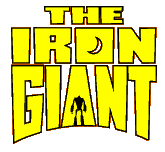
Cast * Interesting Facts * Brad Bird Interview * Production Details

Cast * Interesting Facts * Brad Bird Interview * Production Details
Directed by: Brad Bird
Written by: Ted Hughes (book) & Brad
Bird
Music by: Michael Kamen
Production begun on: September 2nd, 1997
Released on: August 6, 1999
Running Time: 86 minutes
Budget: $48 million
U.S. Opening Weekend: $5.732 million over
2,179 screens
Box-Office: $23 million in the U.S., $
million worldwide
Hogarth Hughes... Eli Marienthal
The Iron Giant... Vin Diesel
Annie Hughes... Jennifer Aniston
Dean McCoppin... Harry Connick Jr.
Marv Loach/Floyd Turbeaux... James Gammon
Mrs. Tensedge... Cloris Leachman
Kent Mansley... Christopher McDonald
General Rogard... John Mahoney
Earl Stutz... M. Emmet Walsh
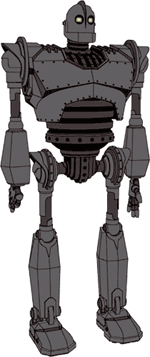 |
 |
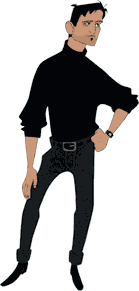 |
|
 |
![]() Director Brad
Bird reportedly did Iron Giant in order to retain the rights of
his dream project Ray Gunn which he almost lost when Turner was
"subsumed" by Time/Warner. "Ray Gunn is a detective in an alternate future.
It's a cross between Raiders of the Lost Ark and Sam Spade. It is a little
harder edged than The Iron Giant, but I think it has something to say and
a lot of action. It's a great project and it would be a very exciting film.
If The Iron Giant is a success, Ray Gunn will get a little closer
to getting made. It would be tremendous."
Director Brad
Bird reportedly did Iron Giant in order to retain the rights of
his dream project Ray Gunn which he almost lost when Turner was
"subsumed" by Time/Warner. "Ray Gunn is a detective in an alternate future.
It's a cross between Raiders of the Lost Ark and Sam Spade. It is a little
harder edged than The Iron Giant, but I think it has something to say and
a lot of action. It's a great project and it would be a very exciting film.
If The Iron Giant is a success, Ray Gunn will get a little closer
to getting made. It would be tremendous."
![]() Sherry Lynn has
appeared in many animated movies: she was cast as an "additional voice"
in Beauty and the Beast (1991),
Little
Nemo: Adventures in Slumberland (1992),
Aladdin
(1992), Final Fantasy: Legend of the Crystals (1994), Toy
Story (1995), Hercules (1997),
A
Bug's Life (1998), Tarzan (1999),
and Toy Story 2 (1999). She also was
one of the children's voices in Dreamworks'
The Haunting (1999).
Sherry Lynn has
appeared in many animated movies: she was cast as an "additional voice"
in Beauty and the Beast (1991),
Little
Nemo: Adventures in Slumberland (1992),
Aladdin
(1992), Final Fantasy: Legend of the Crystals (1994), Toy
Story (1995), Hercules (1997),
A
Bug's Life (1998), Tarzan (1999),
and Toy Story 2 (1999). She also was
one of the children's voices in Dreamworks'
The Haunting (1999).
![]() The very prolific Cloris Leachman (b. 1926) was Queen Gnorga in A Troll
in Central Park (1993) and Phyllis Lindstrom in The Mary Tyler Moore
Show (1970-1975).
The very prolific Cloris Leachman (b. 1926) was Queen Gnorga in A Troll
in Central Park (1993) and Phyllis Lindstrom in The Mary Tyler Moore
Show (1970-1975).
![]() The Iron Giant
was originally intended as a musical, but Brad Bird decided that it just
wouldn't work that way.
The Iron Giant
was originally intended as a musical, but Brad Bird decided that it just
wouldn't work that way.
![]() "Frank" and "Ollie",
the two trainmen that Kent interviews after the derailment, are caricatures
of Disney classic animators Thomas, Frank and Ollie Johnston. Oliver
M. Johnston Jr. actually voiced his character: he is one of Disney's most
famous animators, and worked on Fantasia
(1940), Bambi (1942), Peter
and the Wolf (1946), The
Adventures of Ichabod and Mr. Toad (1949), Cinderella
(1950), Alice in Wonderland
(1951), Peter Pan (1953), Lady
and the Tramp (1955),
Sleeping
Beauty (1959), 101 Dalmatians
(1961),
The Sword in the Stone
(1963), Mary Poppins (1964), The
Jungle Book(1967), Winnie
the Pooh and the Blustery Day (1968),
The
Aristocats (1970),
Robin Hood
(1973), The Many Adventures
of Winnie the Pooh (1977), and The
Fox and the Hound (1981).
"Frank" and "Ollie",
the two trainmen that Kent interviews after the derailment, are caricatures
of Disney classic animators Thomas, Frank and Ollie Johnston. Oliver
M. Johnston Jr. actually voiced his character: he is one of Disney's most
famous animators, and worked on Fantasia
(1940), Bambi (1942), Peter
and the Wolf (1946), The
Adventures of Ichabod and Mr. Toad (1949), Cinderella
(1950), Alice in Wonderland
(1951), Peter Pan (1953), Lady
and the Tramp (1955),
Sleeping
Beauty (1959), 101 Dalmatians
(1961),
The Sword in the Stone
(1963), Mary Poppins (1964), The
Jungle Book(1967), Winnie
the Pooh and the Blustery Day (1968),
The
Aristocats (1970),
Robin Hood
(1973), The Many Adventures
of Winnie the Pooh (1977), and The
Fox and the Hound (1981).
![]() In the scene where
Kent is using the Hughes' phone, the humorous oven mitt hanging on the
wall beside him appears to be a stylized version of the "family dog" from
Bird's animated short of the same title which appeared on "Amazing Stories".
In the scene where
Kent is using the Hughes' phone, the humorous oven mitt hanging on the
wall beside him appears to be a stylized version of the "family dog" from
Bird's animated short of the same title which appeared on "Amazing Stories".
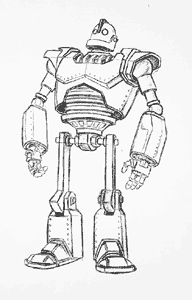
![]() When Hogarth first shows the Giant his Superman comics, the theme music
from the Max Fleischer Superman cartoons of the 1940's is heard in the
background.
When Hogarth first shows the Giant his Superman comics, the theme music
from the Max Fleischer Superman cartoons of the 1940's is heard in the
background.
![]() Pete Townshend
of The Who execute produced the movie, and produced a concept album based
on the same book as the film.
Pete Townshend
of The Who execute produced the movie, and produced a concept album based
on the same book as the film.
![]() "Floyd Turbeaux"
is the name of the flannel-wearing rube played by Johnny Carson to lampoon
the National Rifle Association.
"Floyd Turbeaux"
is the name of the flannel-wearing rube played by Johnny Carson to lampoon
the National Rifle Association.
![]() Brad Bird explained
that "for the longest time, we did not have a release date and that killed
us with the number of tie-ins and toys. We would get them interested in
the film and they would ask when the film is coming out and we wouldn't
know. You have to plan these things a year in advance. We lost a lot of
tie-ins that we would've had if Warner had given us a release date. Given
that, when we spoke to Trendmasters (Toys), we expected them to react the
same way, but they said they would sit on it until the film came out. Because
of them, you can go to the Warner Bros. Stores and get the toys today."
Brad Bird explained
that "for the longest time, we did not have a release date and that killed
us with the number of tie-ins and toys. We would get them interested in
the film and they would ask when the film is coming out and we wouldn't
know. You have to plan these things a year in advance. We lost a lot of
tie-ins that we would've had if Warner had given us a release date. Given
that, when we spoke to Trendmasters (Toys), we expected them to react the
same way, but they said they would sit on it until the film came out. Because
of them, you can go to the Warner Bros. Stores and get the toys today."
![]() Warner Bros. posted
10 minutes of its animated picture on the Web back in 1999, in an attempt
to replicate Artisan Entertainment's success with selling The Blair
Witch Project to Internet users.
Warner Bros. posted
10 minutes of its animated picture on the Web back in 1999, in an attempt
to replicate Artisan Entertainment's success with selling The Blair
Witch Project to Internet users.
![]() On August 6, 1999,
The
Iron Giant opened throughout the U.S. with rave reviews from critics
everywhere. The film was hailed as a "solid and ironclad winner," "intelligent,"
"well-crafted," and "visually appealing." The poor marketing campaign
of Warner Bros was blamed for the box-office failure of this movie.
On August 6, 1999,
The
Iron Giant opened throughout the U.S. with rave reviews from critics
everywhere. The film was hailed as a "solid and ironclad winner," "intelligent,"
"well-crafted," and "visually appealing." The poor marketing campaign
of Warner Bros was blamed for the box-office failure of this movie.
![]() This film won
9 major awards at the 1999 Annies, which honors excellence in animation.
The categories the film won are: Best Picture, Director, Writing, Voice
Acting (young Eli Marienthal), Music, Character Animation, Effects Animation,
Production Design, and Storyboarding.
This film won
9 major awards at the 1999 Annies, which honors excellence in animation.
The categories the film won are: Best Picture, Director, Writing, Voice
Acting (young Eli Marienthal), Music, Character Animation, Effects Animation,
Production Design, and Storyboarding.
![]() In May 2000,
Brad Bird signed with Pixar studios to work on an unnamed film that the
studio plans to release in 2004.
In May 2000,
Brad Bird signed with Pixar studios to work on an unnamed film that the
studio plans to release in 2004.
August 5, 1999 interview by The
Movie Guys: Jeffrey K. Howard and Dave Neil (lasvegasweekly@lasvegasweekly.com)
Q: How much different was the book The Iron Giant compared to the film? I heard that the setting was changed?
That was one of them, setting the story in a different time period,
but the storyline itself is different from the book. About halfway through
the book, it gets away from the story about the boy and the giant robot
and becomes a contest between the giant and a space bat, which is the size
of Australia. I like the book very much, but I felt as a movie, the strength
lied in the relationship between the boy and the robot. The Kent character
isn't in the book. Nor is the beatnik character; those were my creations.
Q: Was this your first attempt to write your own screenplay?
Not my first screenplay, but it's the first one that they allowed me
to do (laughs). I've tried a few times to do things and to try and deviate
from the formula and this is the first one that they've left me alone.
I think it's because it has elements that are familiar, by having a boy
as the lead character, it feels somewhat kid-friendly.
Q: How much freedom did Warner Bros. give you in creating The Iron Giant?
A terrific amount, but not totally hands off. They didn't simply give
me the money and the release date and say "See you later." They were involved
in every scene and how the story was developed and certainly questioned
everything that deviated from the formula as we know it. Every time something
was different they would ask "Why are you doing that?" To their credit,
I gave them an answer that sounded intelligent and reasonable and they
would finally say, "OK." That was the big enticement in doing this project,
because we didn't have the budget that a Disney film or Dreamworks would
have. We didn't have the schedule. The team we had was, in general, less
experienced but very talented. We had tremendous leeway to make the film
we saw fit and if we had a good idea, we could act upon it without having
to submit it to a team of vice-presidents. I was working with someone who
could say "yes," which is the key to being able to make a distinctive film
in Hollywood.
Q: Why did you choose to set the film in 1957, during the Cold War?
There was something about the contrast between Father Knows Best, pleasant,
well-manicured surface of the 1950s and that underneath it was this fear
going on that no one spoke about much but everyone was feeling. I think
the only films from that era that were really dealing with our dread of
technology, the future, the bomb and where science is taking us, were the
horror and sci-fi films of the 1950s. That was certainly interesting to
me on a pop level, but I think on another level, if you're dealing with
a big metal man from outer space, a climate of fear helps -- dramatically.
Q: How was it decided to use computer animation vs. traditional hand drawings for the Iron Giant?
I always knew that it was best to use a computer for animating the Iron
Giant. Our concerns were, how do we make those scenes compatible with the
hand animation, because none of us were happy with the previous attempts
to blend the two. We always felt you could see the difference. We worked
very hard to eliminate anything that separated
the two.
Q: The character of the small boy, Hogarth, comes alive with the voice of Eli Marienthal. He has the perfect voice, actions and a great sense of timing. How did you find him? Did he audition along with a million other kids?
Exactly right. We saw every kid between the ages of seven to 14 years
old. Every single one, and I mean "everyone." You could name any film and
we saw that kid. Eli just had a rough, playful quality to his voice and
he sounded intelligent and childlike at the same time. He was game to go
in any direction that we wanted and that made him a delight to work with.
I hadn't seen any of his films, but I just liked what he did when he read
for me.
Q: Why did you mention Superman in the film? Is that a reference to the early Max Fleicher Superman cartoons?
Well, I have a lot of influences and I was certainly a fan of the Fleicher
Superman cartoons. I think they were tremendously well-staged and exciting.
But hey, when you think of kids and their literature, for better or for
worse, that's comic books. If you think of a comic book hero, quick! (snaps
his fingers) the first thing off your tongue is Superman. Some other journalist
accused me of shilling for Warner Bros., because Warner owns Superman.
I told him that I would've asked to use Superman if I had made this film
at Paramount or at any other studio. He's the hero you think of. I asked
for a lot of things for this film that I didn't
get, because they belonged to other companies. I wanted to advertise
the Cinemascope logo, which is a defunct process and it was owned by 20th
Century Fox. (Getting riled up.) They wouldn't take money for it, probably,
because someone thought (Fox Chairman) Rupert (Murdoch) and Ted (Turner)
don't get along. I'm sure that Rupert and Ted don't give a flying fuck
about the Cinemascope logo.
Q: Does The Iron Giant have an anti-gun message?
A lot of people are taking it that way, but it was my intention to talk
about the violent sides of our nature and whether or not to act upon them.
Q: Most animation is shipped off overseas to be produced in countries like Korea. Was The Iron Giant produced and animated in the United States?
Absolutely. A couple of scenes were animated by a man in England, but
not very much, then he sent it here to be finished off. It's all about
control. I think that the more miles you put between you and the people
that are executing the film, the more you lose control, but it was all
animated in America.
Q: Were you involved with the marketing and production of the toys for the film?
Sure, but for the longest time, we did not have a release date and that
killed us with the number of tie-ins and toys. We would get them interested
in the film and they would ask when the film is coming out and we wouldn't
know. You have to plan these things a year in advance. We lost a lot of
tie-ins that we would've had if Warner had given us a release date. Given
that, when we spoke to Trendmasters (Toys), we expected them to react the
same way, but they said they would sit on it until the film came out. Because
of them, you can go to the Warner Bros. Stores and get the toys today.
Q: Tell us about your dream animation project, Ray Gunn.
Ray Gunn is a detective in an alternate future. It's a cross between
Raiders of the Lost Ark and Sam Spade. It is a little harder edged than
The Iron Giant, but I think it has something to say and a lot of action.
It's a great project and it would be a very exciting film. If The Iron
Giant is a success, Ray Gunn will get a little closer to getting made.
It would be tremendous.
About the Production ![]() Building a Better Giant
Building a Better Giant![]() A Rock and a Hard Place
A Rock and a Hard Place ![]() The Giant Talks
The Giant Talks ![]() Young
At Heart
Young
At Heart
About the Production
In 1968, a children’s book by British Poet Laureate Ted Hughes (1930-1998) was published –its title in the U.K. was The Iron Man and, in the United States, The Iron Giant. The story of a huge robot and its friendship with a young boy grew out of a story told by Hughes to comfort his and American poet Slyvia Plath’s (1932-1963) two children following their mother’s death.
In 1986, rock musician Pete Townshend (one of the founders of the British band The Who) became interested in writing "a modern song-cycle in the manner of ‘Tommy’" and chose as his subject Hughes’ book, The Iron Man. Three years later, "The Iron Man" album was released and, in 1993, a stage version was mounted at London’s Old Vic.
Prolific theatrical producer/director Des McAnuff, who had adapted the Tony Award-winning "The Who’s ‘Tommy’" with Townshend for the stage, believed that "The Iron Man" could translate to the screen, and the project was ultimately acquired by Warner Bros.
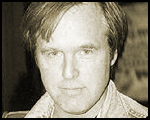 Towards
the end of 1996, while "The Iron Man" project was working its way through
development, Brad Bird was developing a feature for Turner during the period
when Turner had been merged with Warner Bros. The noted animation writer
and director had worked on such groundbreaking television projects as "The
Simpsons," "The Critic" and "King of the Hill" and the had rightfully earned
the reputation as an up-and-coming force in the resurgence of the popularity
of animation. (Bird had also written, directed and co-produced the acclaimed
"Family Dog" that aired on Steven Spielberg’s weekly television anthology
series, "Amazing Stories.")
Towards
the end of 1996, while "The Iron Man" project was working its way through
development, Brad Bird was developing a feature for Turner during the period
when Turner had been merged with Warner Bros. The noted animation writer
and director had worked on such groundbreaking television projects as "The
Simpsons," "The Critic" and "King of the Hill" and the had rightfully earned
the reputation as an up-and-coming force in the resurgence of the popularity
of animation. (Bird had also written, directed and co-produced the acclaimed
"Family Dog" that aired on Steven Spielberg’s weekly television anthology
series, "Amazing Stories.")
Following the Turner/Warner Bros. merger, Bird was invited to come to Warner Bros. Animation–the studio of such classic animators as Friz Freleng and Chuck Jones–to discuss working on a film for the studio. While at Warners, Bird viewed sample artwork from projects the studio had in development and there he saw a drawing "of a young boy and a giant robot. It stuck with me. Later, when the Turner thing didn’t work out, Warners asked me if there was anything I was interested in. I read the Ted Hughes book and I really liked the basic mythology of the story, but I had something pretty different in mind. So I pitched my version of ‘The Iron Giant’ and they went for it."
Bird’s version of Hughes’ tale kept the central characters of the story, but surrounding the relationship between Hogarth and the Giant, the director put a distinctly American spin on the 30-year-old British children’s book.
He explains, "Hughes’ book is a great story that tries to show kids about the cycle of life–even though there is death, life has a continuity. My version is based around a question I asked the execs at Warner Bros.–what if a gun had a soul and chose not to be a gun? Basically I wanted to honor the book, but also take it in a new direction."
Screenwriter Tim McCanlies worked with Bird to realize the script. Bird comments, "Tim and I had a wonderful experience collaborating on ‘The Iron Giant.’ I first fell in love with Tim’s work when I read his screenplay ‘Second Hand Lions.’ I knew then that he was the perfect writer to help bring ‘The Iron Giant’ to the screen. Tim’s writing has a sweetness and an innocence to it which speak to the very core of our film."
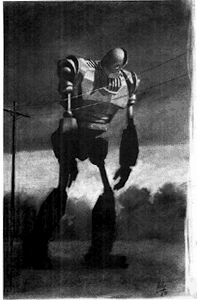 Later
during production, the filmmakers sent Ted Hughes a copy of "The Iron Giant"
script. The author sent a letter back, saying how pleased he was with Bird’s
version. In the letter, Hughes rather poetically stated, "I want to tell
you how much I like what Brad Bird has done. He’s made something all of
a piece, with terrific sinister gathering momentum and the ending came
to me as a glorious piece of amazement. He’s made a terrific dramatic situation
out of the way he’s developed The Iron Giant. I can’t stop thinking about
it…"
Later
during production, the filmmakers sent Ted Hughes a copy of "The Iron Giant"
script. The author sent a letter back, saying how pleased he was with Bird’s
version. In the letter, Hughes rather poetically stated, "I want to tell
you how much I like what Brad Bird has done. He’s made something all of
a piece, with terrific sinister gathering momentum and the ending came
to me as a glorious piece of amazement. He’s made a terrific dramatic situation
out of the way he’s developed The Iron Giant. I can’t stop thinking about
it…"
Bird broke with Hughes’ tale by adding key new characters and altering both the setting of the story and the origin of the giant. He explains, "It’s now set in America in 1957. It deals with things like Cold War paranoia, and we have new characters like Dean, the beatnik, and Kent Mansley, the government agent. Also, the giant comes from outer space, where in the original story, he just emerges from the ocean."
The shift in setting was carefully considered by Bird. He continues, "The 50s are a wonderful time in which to set this movie. America was at a crossroads. We were learning to live with the atom bomb; the space race was just beginning; paranoia was at a high; and all of this got into the movies of the time…giant ants and mutated Martian men. That’s a pretty funny response to all of those influences. So if you’re going to have a story about a human boy who befriends a metal man, it’s fitting to put it into the context of the fear that existed at that time.
"Maine is primarily a rural setting. There’s something about juxtaposing a large technological creation with farmland and trees–a big, shiny metal thing looks completely out of place. There’s also an innocence and a Norman Rockwell-type of feeling with that place, and I wanted to see the idea of innocence being visited upon by paranoia," he explains.
Key to the filmmaker’s retelling of The Iron Man is the giant’s fundamental purpose–whatever its origin, it was undoubtedly created as a weapon…a gun with a soul.
"In our version of the story, the boy is basically the parent and the giant is the child. I think that each one of us has both the potential for great good and for horrible destruction. Every day, in big and small ways, we are choosing which side of us we are going to act on. Hogarth helps this machine–that is built for another purpose–to find a different side of itself, and it becomes somewhat human in the process," the director concludes.
Bird’s pitch to Warner Bros. was in late 1996. A deal was made, and work began on "The Iron Giant" on January 2, 1997.

Allison Abbate had just completed co-producing the animation on the Warner Bros. hit feature "Space Jam" when she was brought on board to produce "The Iron Giant." The pre-production period began in what was to be a tight schedule, and the filmmakers literally started with only Bird’s treatment and a few preliminary pieces of art. Abbate began her duties as producer by assembling a team of supervisors who would actualize Bird’s vision.
Abbate remembers, "Once we were given the green light to begin pre-production, Tim McCanlies and Brad started writing the script and working simultaneously with the story board artists. We began with just a treatment and Brad would bat ideas back and forth with the story board artists–it was an amazingly dynamic time, and it really allowed all of us to get into Brad’s head. We hammered away at it and by August, we had about 30 minutes of the film story boarded and we were given our green light to go into production."
 The
conscious decision had been made to create the majority of the main characters
using the classic two-dimensional animation process. But even at the earliest
stages of development, filmmakers were using technology to push the envelope
of the classic animation process. Scenes begin to unfold during the story
boarding phase as still pencil sketches; however, on "The Iron Giant,"
the artists enhanced the story reel (the filmed compilation of the pencil
sketches) by adding camera moves and simple effects to the drawings, giving
them the look of rough animation. Much of the mechanics and dynamics of
the shots were worked out during this early stage.
The
conscious decision had been made to create the majority of the main characters
using the classic two-dimensional animation process. But even at the earliest
stages of development, filmmakers were using technology to push the envelope
of the classic animation process. Scenes begin to unfold during the story
boarding phase as still pencil sketches; however, on "The Iron Giant,"
the artists enhanced the story reel (the filmed compilation of the pencil
sketches) by adding camera moves and simple effects to the drawings, giving
them the look of rough animation. Much of the mechanics and dynamics of
the shots were worked out during this early stage.
From these early sketches, characters began to emerge. Head of animation Tony Fucile was in charge of assembling the team of animators who created the characters and their world. He explains, "Once design begins on the characters and the look of each is approved, we wind up with something called model sheets, which function as blue prints for the character. Basically, character designs are taken and then rotated in space so animators can figure out how to draw them from all angles. We experiment with various emotions, facial expressions and body positions. This gives the animator more freedom, because he has studied what shapes are underneath the skull, how the ears are attached, that sort of thing."
The model sheets would prove even more valuable on this film, as Bird had chosen to give artists entire scenes (or chunks of the film), rather than assigning one head animator the responsibility for a particular character (as has become customary in recent films). Bird and Fucile worked side-by-side with the staff drawing the characters "on model," ensuring that the animators draw the characters in a homogenous style, downplaying their own differences in personal styles or ability.
"Everyone is trying, especially at the beginning, to figure out ‘how
do I draw these characters?’ We have about 50 animators and 75 or so clean
up artists [who literally ‘clean up’ the animator’s drawings], so we’ll
have about 125 people working on the same character. We didn’t want Hogarth
to suddenly turn into somebody else," comments Fucile.

The title character of the film, however, is made of metal, which posed an interesting challenge for the artists. Bird comments, "It is difficult for a human to draw a big, solid metallic object. Animators excel at drawing movement and living, fluid objects. The giant originates from a different world, so we chose to create the giant using computer animation, CGI, which would give him the mass and solidity and also give the impression that it’s from a different place. The separation between the 2D-animation and the CGI is something that helped establish the fish-out-of-water facet of the story."
Filmmakers took great care, however, to bring the giant into Hogarth’s world, not wanting the character to appear so foreign that it would not mesh into the scenes in and around Rockwell, Maine in 1957. Bird explains, "I gave the crew sort of an edict–imagine that this is 1940 during the golden age of animation. How would you draw something like this by hand? So we simplified the character’s shapes and also analyzed the qualities of hand-drawn animation versus computer animation, ultimately looking for ways to meld the two."
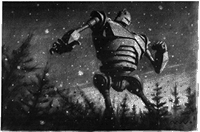 Animators
knew that computer-generated lines are exact and lines rendered by hand
are imperfect. ("We took months to create a computer program that actually
wobbles the lines of the giant a bit–just enough so that it feels hand-drawn,"
adds Bird.) Existing special software was also extended and modified to
accomplish a myriad of things–aiding in shading of the giant, varying the
lightening and darkening of some frames and altering grain patterns–to
affect the giant’s realistic inclusion in his strange new (and classically
animated) world.
Animators
knew that computer-generated lines are exact and lines rendered by hand
are imperfect. ("We took months to create a computer program that actually
wobbles the lines of the giant a bit–just enough so that it feels hand-drawn,"
adds Bird.) Existing special software was also extended and modified to
accomplish a myriad of things–aiding in shading of the giant, varying the
lightening and darkening of some frames and altering grain patterns–to
affect the giant’s realistic inclusion in his strange new (and classically
animated) world.
The first sketches of the giant were completed by Joe Johnston, who then worked with Bird and production designer Mark Whiting and supervising CGI animator Steve Markowski. Whiting shaped the giant’s look to match the bucolic landscapes he had meticulously designed for the film; Markowski brought the giant to life with movement. The giant designers also incorporated visual references from period sci-fi films, such as "The Day the Earth Stood Still," in creating their "homage" to the giant robots of the post-nuclear horror films.
"But there is also an innocence to the giant," counters Abbate. "His design is very simple and clean. We wanted him to appear almost like a baby at the beginning of the film. He’s a little bit like all of us–we all start out not knowing who we are, where we come from or why we’re here and we all have to choose our life path."
Someone else who contributed to the realization of the giant was artistic coordinator Scott Johnston, who drew on his extensive experience in computer graphics to help Bird and his staff of artistic supervisors solve the problems inherent in mixing classic animation with CGI.
"We wanted the giant to be an alien presence," offers Johnston. "We also wanted to keep the rigidity of his form, yet allow him to be able to express a wide range of emotions. He has a simple jaw shape that can’t really bend into a smile or a frown, but he has other ways of expressing thoughts and ideas through physical movements."
Early in the production, the filmmakers and staff had traveled to Maine to absorb the feel of the film’s setting. Abbate comments, "Brad liked Maine for its innocence, and we chose the time period because it was an era before people became jaded. Maine is rugged and beautiful, and graphically, a little stark. It is also a place and a time where you would be able to hide a big, giant robot in a small town and not have it discovered for a few days. We also wanted to set the story in the fall, starting with colorful foliage and ending with snow."
Filmmakers also looked to period artists, such as Norman Rockwell, Edward
Hopper and N.C. Wyeth, for their style and use of color. Period magazines,
graphics and films were additional inspirations for the look of the film.
The decision was also made to shoot the film in "wide screen," a format
popularized in the 1950s.
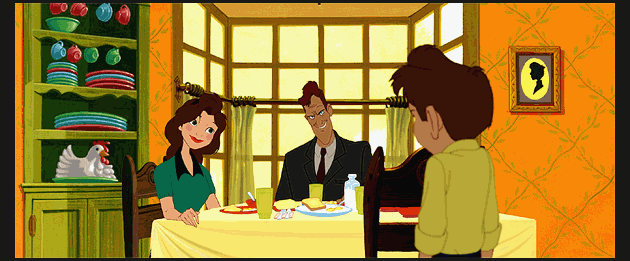
Strong choices had been made with regard to the appearances of the characters and the specifics of their world. Director Bird had equally strong views about the voices that would aid in bringing the characters to life.
He says, "I am not a huge fan of designing characters to have the look of the celebrity voicing it. I feel that’s a very limited way of thinking. I prefer to approach the whole issue by asking, ‘Who is the character and how does that character look?’ Then I find a voice to suit the character. I mean, Homer Simpson looks nothing like Dan Castellaneta, who voices him. I like to find a voice that compliments the design of the character."
Bird continues, "I look for actors with distinctive voices. In live-action films, actors can use their whole bodies to convey who they are. The challenge here is to make sure all of the nuances of character can come through with just the voice. That serves the animation as well. It you want the best out of your artists, you want to give them a soundtrack that’s inspiring. You also don’t want to hamstring the animators into any kind of visual acting–you want them to invent stuff to go with the voice. So the voice should inspire the animator, and the better the voice, the better the animation."
Filmmakers chose Jennifer Aniston, television’s Rachel on the long-running Nielsen hit "Friends" and star of several feature films, as the independent Annie Hughes. "She’s a play on the usual 1950s mom," says Abbate. "We updated her. She’s single, working, young and attractive. She’s far from your usual Donna Reed-type ‘mom.’"
"The thing I liked about Annie and this project," observes Aniston, "is that it’s not at all what’s expected. She’s more like a mom from the 70s than the 50s. She’s very strong, like a mother tiger protecting her son, Hogarth. She’s funny and really spunky, in that great kind of Laura Petrie way. There’s also a tremendous heart to the story. I’m really happy to have been involved in the film."
Grammy-winning musician and actor Harry Connick, Jr. was cast to voice the role of Dean McCoppen, a beatnik sculptor who owns a junkyard that serves as the giant’s temporary home. Abbate comments, "Dean is an outsider in this small, somewhat conservative town. Harry Connick was the perfect choice–he just exudes that cool cat kind of beatnik mentality. Plus, he has that southern drawl so he sounds like he’s an outsider."
"I had an idea immediately who Dean was," says Connick. "I grew up in the South surrounded by guys who see the world in different way. Artists, jazz musicians, crazy guys in New Orleans. I had a blast working on this project."
For Hogarth, Bird wanted a fresh young voice with a quality different from most child actors. "Hogarth needed to be innocent, but tough enough to be on his own most of the time. Hogarth has lost his father, plus he’s too smart for the kids his own age, so he’s developed a great imaginary world of his own making. He’s always on the lookout for nuclear monsters or invaders from outer space, but he’s also constantly rescuing animals who need a home."
Eli Marienthal, a then 12-year-old theatrical actor with several television and feature credits, filled the role of Hogarth. He says, "I think Hogarth lives in an imaginary world, so when the giant comes along, he’s sort of fulfilling Hogarth’s fantasy. I really think it’s more a story about friendship than just a story about a boy and a giant. I also really think that there’s so much of Brad Bird in Hogarth that there is no way I could have done it without him."
(Scott Johnston also comments on Hogarth’s powerful imagination and enthusiasm for life. He says, "When I look at Hogarth, I can get a sense of what Brad must have been like as a kid.")
For the voice of Kent Mansley, the government agent bent on discovering and ultimately destroying the giant, filmmakers cast feature film regular Christopher McDonald, for whom Bird tailored the role. Abbate says, "Christopher has that perfect combination of good looks and strength, plus he can also be funny, self-deprecating and even just plain evil–and that all comes through in his voice. We actually made it a point of designing Kent to look like the stereotypical perfect father so that he would really fit into the family of Annie and Hogarth. We wanted him to look like the all-American guy but be evil to the core."
"I play Kent, and he’s pretty full of himself. He wants to break out of the bowels of Capitol Hill, where he has this little windowless office," elaborates McDonald. "I had done animation before, doing the voice of Jor-El for the series of ‘Superman.’ Your imagination takes over and the possibilities are limitless. But it’s also very challenging because it’s only the voice that comes through. In a way, it’s a little like Shakespeare, because the words are key."
For the key role of the Iron Giant, filmmakers signed actor and filmmaker Vin Diesel. Abbate explains, "In the beginning, the giant is really not able to speak–he wasn’t designed to speak. So his first words are very mechanical sounding. Toward the end of the film, his voice becomes more human. We were going to be electronically modulating the giant’s voice for that mechanical sound, but we needed a deep, resonant and expressive voice to start with. Vin’s voice is great. You can really hear his heart. He makes the giant imposing but still charming."
Diesel felt a kinship with the giant, saying, "The Iron Giant is misunderstood. His strength is the bane of his existence and despite the fact that he’s designed as a killing machine, he is really as simple as a child. I’ve always said that I feel like a bull in a china shop, and with the giant, he moves to scratch his back and buildings fall. Actually, I think we came from the same planet. "I’m an animated actor, so to speak," continues Diesel. "I use my body, my hands, my expressions. And in doing this kind of work, all of that is irrelevant, all of that is erased. The voice–it was a luxury to just get behind the microphone and go to work."
To round out the cast, filmmakers hired an esteemed group of actors
with an amazing and varied list of credits. Veteran actor and Tony-winner
John Mahoney wore the stars as Kent’s boss, General Shannon Rogard. Familiar
character actor M. Emmet Walsh gave the wild-eyed fisherman (who sees the
giant fall into the ocean), Earl Stutz, his voice. Accomplished actor James
Gammon voiced two of the townspeople, Marve Loach and Floyd Tubeaux, and
Oscar-winner Cloris Leachman stepped into the shoes of Hogarth’s teacher,
Mrs. Tensedge.

As a means of paying homage to the generations of animators who inspired Bird and assisted him in his career, the filmmakers enlisted the help of two classic animation veterans–Victor Haboush and Ray Aragon. Producer Abbate says, "Victor and Ray really helped us in the early stages of visual development, especially when we visited Maine and began to adopt the style of our story. They were an inspiration. In some ways, Victor and Ray also helped us bring Dean to life–both were these incredibly creative guys who were artists and ‘cool cats’ in the 50s."
The director was also intent on actively involving current students at Cal Arts on the film. While staffing, Bird saved spots for several students to work as rough in-between artists (who take animators’ key character poses and execute all drawings in between to complete action on segments of the film). Bird hired four animators who had worked together on an animated short at school. Later, impressed with the group’s skills, the director offered to let the four animate an entire sequence of "The Iron Giant"–fittingly, a scene in a classroom.
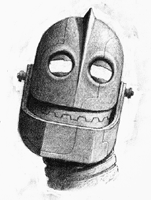 He
says, "We had a very young crew and they were completely on fire, and I
have to say we really used that. I wouldn’t have given it to them if I
didn’t think they could handle it. The Cal Arts students animated their
sequence and then returned to school. There were quite a few stories like
that on this film where what we lacked in experience, we more than made
up for with passion and enthusiasm."
He
says, "We had a very young crew and they were completely on fire, and I
have to say we really used that. I wouldn’t have given it to them if I
didn’t think they could handle it. The Cal Arts students animated their
sequence and then returned to school. There were quite a few stories like
that on this film where what we lacked in experience, we more than made
up for with passion and enthusiasm."
Allison Abbate comments, "Everyone was really motivated to keep to our tight schedule. I actually think that not having an extended period of development helped us in a way. There is less wasted time because the artists have an investment in their sequences and they work together to solve problems immediately as they arise. Having Brad at the helm kept us all very clear about the vision. It was exhausting and it was great."
(Actor Diesel notes, "Brad directs like a conductor. He literally gets all of the notes by waving his hand.")
One of the advantages of animation over live-action is, as Abbate points out, "getting to see your movie long before it’s going to be finished." Periodically throughout production, the filmmakers assembled the film and looked at it, analyzing everything from story points to character continuity. The film, like any artist’s vision, went through periods of change and growth; some segments were extended, others, eliminated.
"We were given an amazing opportunity to work with this story," reflects the director, "and now, in a way, we get to pass our version on, just as Ted passed it on to his children."
Warner Bros. Presents "The Iron Giant," starring the voices of Jennifer
Aniston, Harry Connick, Jr., Vin Diesel, James Gammon, Cloris Leachman,
Christopher McDonald, John Mahoney, Eli Marienthal and M. Emmet Walsh.
The music is by Michael Kamen. It is executive produced by Pete Townshend.
The screen story is by Brad Bird and the screenplay is by Tim McCanlies,
based on the book, The Iron Man, by Ted Hughes. The film is produced by
Allison Abbate and Des McAnuff. "The Iron Giant" is directed by Brad Bird.
It is distributed by Warner Bros., A Time Warner Entertainment Company.
|
||||||||||||